Indiana's Edible Industry: Food Manufacturing
From Clabber Girl baking powder in Terre Haute to Red Gold tomato products in Orestes, Indiana has become well known for many brand names in the food industry. When visiting a local grocery store, the thought of where the food was made is often far from customers' minds, but the truth is that Indiana claims some big names in the food manufacturing subsector.
The U.S. Census Bureau provides the following description of what industries in the food manufacturing subsector do: “transform livestock and agricultural products into products for intermediate or final consumption.” Typically, these food products are then sold to wholesalers or retailers to distribute to customers.
Nine industries fall into this manufacturing subsector: meat product manufacturing, (1) bakeries and tortilla manufacturing, fruit and vegetable preserving and specialty food manufacturing, dairy product manufacturing, sugar and confectionary product manufacturing, grain and oilseed milling, animal food manufacturing, seafood product preparation and packaging, and other food manufacturing.
United States
In 2006, the food manufacturing industry supplied about 1.5 million jobs nationwide. The majority of the establishments in this industry (89 percent) employed fewer than 100 workers. That said, establishments employing at least 500 workers provided 36 percent of all jobs. (2)
About 34 percent of food manufacturing jobs nationwide are in the meat product manufacturing industry and another 19 percent are employed in the bakeries and tortilla manufacturing industry (see Figure 1). While these two industries employed the most workers, they were among the lowest-paid industries in the food manufacturing subsector.
Figure 1: Percent Distribution of Food Manufacturing Employment in the United States
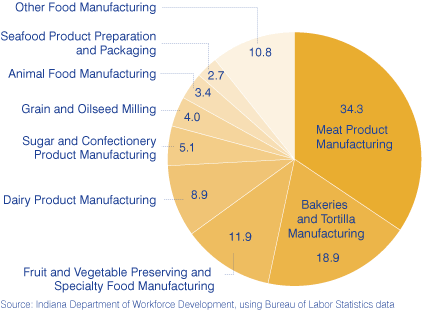
Indiana
According to the 2006 annual average Quarterly Census of Employment and Wages (QCEW) data, Indiana's food processing industry consisted of 487 establishments employing about 32,000 people with an average weekly wage of $688. This represents 5.7 percent of Indiana's manufacturing employment in 2006 and 1.3 percent of the state's total private employment.
Figure 2 shows that the top two industries made up more than half of all employment in Indiana's food manufacturing subsector. Similar to the nationwide numbers, the meat product manufacturing industry employed the most workers in this subsector (26 percent). The bakeries and tortilla manufacturing industry contributed 25 percent of the state's food manufacturing jobs.
Figure 2: Percent Distribution of Food Manufacturing Employment in Indiana
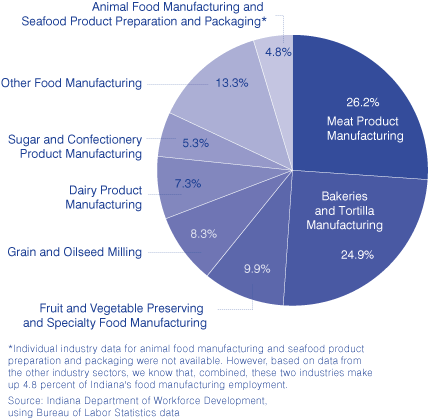
Mirroring the U.S. pattern, the top two industries in the food manufacturing subsector pay among the least. Meat product manufacturing paid the lowest average wages, and bakeries and tortilla manufacturers paid the third lowest in both the United States and Indiana for those industries with available data (see Figure 3). Grain and oilseed milling paid the highest average annual wages, around $56,000 for both the state and nation.
Figure 3: Average Annual Wages in the Food Manufacturing Industries, 2006
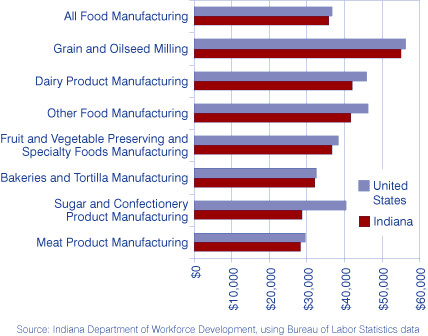
Economic Growth Regions
Indiana's Economic Growth Region (EGR) 4 had the highest percentage of manufacturing workers in the food manufacturing subsector (13 percent). That is pretty substantial, considering manufacturing employment made up 35 percent of total employment in the region (see Figure 4). The only other region with at least 10 percent of manufacturing employment in the food manufacturing subsector was EGR 10.
Figure 4: Percent of Employment in Manufacturing and Food Manufacturing in Indiana's Economic Growth Regions, 2006
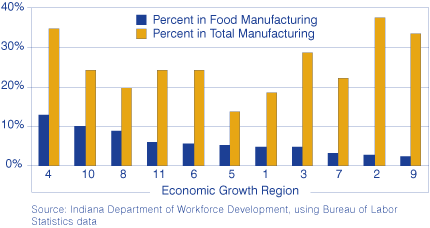
Since EGR 5 makes up about 30 percent of Indiana's total jobs, one might expect this region to lead the state in the raw number of food manufacturing employees. Surprisingly, however, EGR 4 had the highest employment numbers for the food manufacturing industry as well. However, EGR 5 is growing and had the largest numeric gain in jobs from 2001 to 2006, followed by EGR 11 and EGR 3, respectively (see Figure 5). Seven of the regions posted gains in employment during that time.
Figure 5: Food Manufacturing Employment by Economic Growth Region, 2001 to 2006
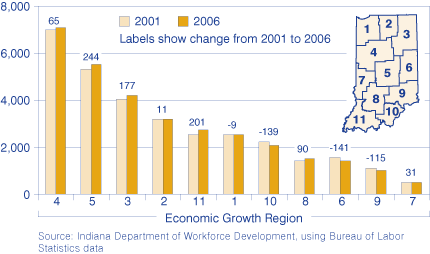
Since EGR 4 had the largest number of people employed in the food manufacturing industry, let's dig a little deeper into which companies are actually located in the area. Doing so shows some well-known manufacturers in the region. The following businesses employ at least 100 workers in EGR 4:
- A.E. Staley Manufacturing in Lafayette manufactures syrup
- Armour Eckrich Meats in Peru manufactures meat products
- Frito-Lay in Frankfort manufactures potato chips
- Ice Cream Specialties in Lafayette manufactures ice cream and frozen desserts
- Pace Dairy in Crawfordsville manufactures dairy products
- Tyson Fresh Meats in Logansport manufactures meat products
- Zachary Confections in Frankfort manufactures candy and confectionary
Conclusion
The food manufacturing subsector, while making up a relatively small portion of Indiana's overall employment, is a vital piece of Indiana's economic puzzle. The meat processing industry is the most prevalent in the state, followed by the bakeries and tortilla manufacturing industry. EGR 4 appears to be a leader in the food manufacturing subsector when compared to the other 10 economic growth regions, with the highest percentage of manufacturing jobs among the regions and the greatest number of jobs.
Notes
- Meat product manufacturing is officially termed animal slaughtering and processing.
- Bureau of Labor Statistics, U.S. Department of Labor, Career Guide to Industries, 2008–09 Edition, Food Manufacturing, on the Internet at www.bls.gov/oco/cg/cgs011.htm (visited January 11, 2008).
Molly Manns, Associate Editor
Indiana Business Research Center, Kelley School of Business, Indiana University
